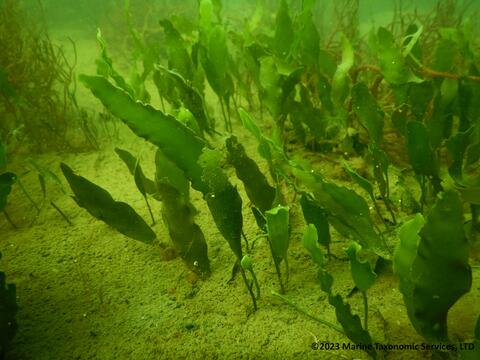San Diego Area Agencies Responding to Discovery of Invasive Seaweed in San Diego Bay
Contact: Brianne Page, 619.348.1518, bpage@portofsandiego.org
Public urged to not drain saltwater aquariums into bays, streams, ponds, or storm drains
The Port of San Diego, along with the Southern California Caulerpa Action Team (SCCAT), the City of Coronado, and the Coronado Cays Homeowners Association (CCHOA), are responding to the discovery of an invasive seaweed scientifically known as Caulerpa prolifera in the Coronado Cays area of San Diego Bay.
Caulerpa is an algae native to Florida and other subtropical and tropical locales. In non-native areas, it can take over natural habitats, disrupting the ecosystem and displacing native plants and the animals that rely on them. In San Diego Bay, state and federally protected eelgrass habitats are especially at risk as eelgrass is utilized by native green sea turtle populations, a threatened species, and 70 different fish species rest within and feed on eelgrass. Caulerpa is not harmful to humans.
It is illegal in California to possess, sell, or transport any Caulerpa seaweed (AB 655,2023). Caulerpa is used primarily in saltwater aquariums. Fines can range from $500 to $10,000 for each violation.
In late September, divers found a small patch of Caulerpa prolifera while conducting an in-water pre-construction eelgrass/Caulerpa dive survey as a permit condition for a dock replacement project. Additional patches were discovered nearby during follow-up surveys. The total find within the Cays is about one-quarter of an acre.
The SCCAT has prepared a Rapid Response Eradication Plan to address the immediate need to eradicate this invasive species. This plan includes the following components:
- Control of Infestation Site – To prevent disturbance by boat anchors and boat wakes, the affected areas are being controlled through coordination with the CCHOA and slip occupants.
- Localized Eradication Level Survey – Diver surveys are being conducted within and adjacent to the affected area. Divers locate, record, and map any Caulerpa prolifera found.
- Treatment – The Caulerpa prolifera is being covered by trained divers with a sealed barrier that will kill the algae by exclusion from light, oxygen, and circulation. This method has been successfully used in the past at other Caulerpa infestation sites in other areas of Southern California.
- Post Treatment Surveys – Diver surveys will be conducted both immediately following treatment and over a longer timeframe to help ensure the species is completely eradicated and does not repopulate the area.
- Broad Area Surveys – Diver surveys will occur in surrounding areas of San Diego Bay to determine if other areas have been invaded.
The estimated cost for the surveys and eradication is to be determined. The Port of San Diego has contributed approximately $92,000 to date. To assist in covering remaining costs, the Port and the U.S. Fish and Wildlife Service have applied for a grant from the Rapid Response Fund for Aquatic Invasive Species. Additional funding may also be available from the State Water Resources Control Board’s Cleanup and Abatement Account. The Port and other parties may be eligible for reimbursement through these funding sources.
Caulerpa can rapidly and aggressively expand from contact with vessels, fishing, and even tidal exchanges. To prevent unintentional spread of this invasive species, boaters, kayakers, swimmers, and divers are asked to avoid the areas, if possible, or to gently transit the channel at high tide.
The most likely source of this infestation is the release from a saltwater aquarium into the bay as Caulerpa, though illegal, is a popular and common saltwater aquarium plant. If you have or sell saltwater aquariums:
- DO NOT use Caulerpa in your aquarium.
- DO NOT dump your aquariums into California waters or even pour the contents into streets or down storm drains that often discharge to the bay or ocean. ONLY drain aquariums into sinks or toilets as the water will circulate to a treatment plant that would help minimize the threat.
- DO NOT share or sell Caulerpa.
If you are a boater, diver, or fisherman:
- Learn what Caulerpa looks like and keep an eye out for it.
- Inspect your anchor, fishing gear, or nets for Caulerpa that may have been picked up from the bottom.
- Learn more and report sightings to the California Department of Fish and Wildlife at wildlife.ca.gov/Conservation/Invasives/Species/Caulerpa.
This is the first discovery of Caulerpa prolifera in San Diego Bay and an infestation in Newport Bay has been battled since 2021. Another species of Caulerpa infested part of Huntington Harbour and Aqua Hedionda Lagoon in Carlsbad in the early 2000s. In California, there has been routine monitoring of Caulerpa since the early 2000s.
The SCCAT includes representatives from the California Department of Fish and Wildlife, Santa Ana Regional Water Quality Control Board, the California Coastal Commission, California State Lands Commission, NOAA Fisheries, Army Corps of Engineers, U.S. Fish and Wildlife Service, and partnerships with the San Diego Regional Water Quality Control Board and State Water Board.
About THE Port of San Diego
The Port of San Diego serves the people of California as a specially created district, balancing multiple uses on 34 miles along San Diego Bay spanning five cities. Collecting no tax dollars, the Port manages a diverse portfolio to generate revenues that support vital public services and amenities.
The Port champions Maritime, Waterfront Development, Public Safety, Experiences and Environment, all focused on enriching the relationship people and businesses have with our dynamic waterfront. From cargo and cruise terminals to hotels and restaurants, from marinas to museums, from 22 public parks to countless events, the Port contributes to the region’s prosperity and remarkable way of life on a daily basis.
ABOUT PORT OF SAN DIEGO ENVIRONMENT
Port of San Diego Environment champions the safekeeping and environmental care of our diverse ecosystems. Year after year, environmental goals are set and measured to evolve environmental initiatives – ensuring San Diego Bay remains a vibrant resource and contributes to a remarkable way of life for visitors and residents for generations to come.
